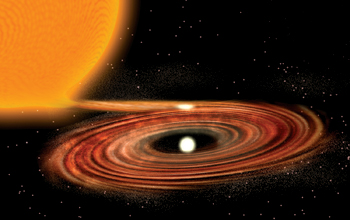Multimedia Gallery
Accretion Disk (Image 1)
An artist's conception of the accretion disk in the binary star system WZ Sagittae (WZ Sge). A newer version has been created using data from Kitt Peak National Observatory (KPNO) and NASA's Spitzer Space Telescope, that can be seen Here.
More about this Image
Observations of an interacting binary star using telescopes at KPNP and NASA's Spitzer Telescope suggest that the disks of hot gas that accumulate around a wide variety of astronomical objects--from white dwarf stars in energetic binary systems to super-massive black holes at the hearts of active galaxies--are likely to be much larger than previously believed.
The target of this specific investigation, named WZ Sge, is an interacting binary star located in the constellation Sagitta, the arrow of the archer Sagittarius. As part of a program, called the Spitzer-NOAO Observing Program for Teachers and Students, Steve B. Howell of the National Optical Astronomy Observatory and a team of astronomers and educators imaged WZ Sge using the National Science Foundation's 2.1-meter telescope and the WIYN 0.9-meter telescope, both located at KPNO, and the infrared array camera (IRAC) on the Spitzer.
Interacting binary stars such as WZ Sge contain a white dwarf star (a compact star about the size of the Earth, but with a mass near that of the sun) and a larger but less massive and much cooler companion star. The companion star has material ripped off its surface by the stronger gravity of the white dwarf. This material flows toward the white dwarf and forms a disk that surrounds it called an accretion disk.
Whether they form in cataclysmic variable systems or they surround the massive black-hole hearts of active galaxies, accretion disks have been well observed and modeled using measurements obtained across much of the electromagnetic spectrum, from X-rays to the near-infrared. The derived picture of the "standard accretion disk" model is a geometrically thin disk of gaseous material surrounding the white dwarf or black hole.
Howell's team obtained the first time series observations of an accretion disk system at 4.5 and 8 microns with the Spitzer. At nearly the same time, they obtained optical observations of WZ Sge at KPNO. The optical observations confirmed the standard view of the accretion disk size and temperature.
The mid-infrared observations, however, were completely unexpected, and revealed that a larger, thicker disk of cool dusty material surrounds much of the gaseous accretion disk. This outer dust disk likely contains as much mass as a medium-sized asteroid. The newly discovered outer disk extends about 20 times the radius of the gaseous disk.
The implications from such a discovery are far reaching, affecting not only the theoretical models (since the formation and evolution of the disks are modeled based on their size, temperature, and composition--all quantities that now need to be revised), but also nearly all previous observations of systems containing accretion disks.
Credit: P. Marenfeld/NOAO/AURA/NSF
See other images like this on your iPhone or iPad download NSF Science Zone on the Apple App Store.
Images and other media in the National Science Foundation Multimedia Gallery are available for use in print and electronic material by NSF employees, members of the media, university staff, teachers and the general public. All media in the gallery are intended for personal, educational and nonprofit/non-commercial use only.
Images credited to the National Science Foundation, a federal agency, are in the public domain. The images were created by employees of the United States Government as part of their official duties or prepared by contractors as "works for hire" for NSF. You may freely use NSF-credited images and, at your discretion, credit NSF with a "Courtesy: National Science Foundation" notation.
Additional information about general usage can be found in Conditions.
Also Available:
Download the high-resolution JPG version of the image. (2.2 MB)
Use your mouse to right-click (Mac users may need to Ctrl-click) the link above and choose the option that will save the file or target to your computer.

